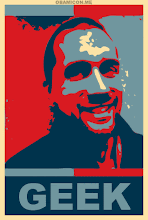Ginny Redish is a founder of Redish & Associates, Inc and an author. Chris Willis is CEO of Media 1.
The theme of this presentation will be "Content as Conversation". Introducing the concept of eLearning as conversation and writing eLearning content as conversation will be topics covered.
Information gets from the designer/developer to the learner in the old model by means of 'one-way transmission'...from PC to student. Faulty because one way does not allow for active questioning...they get what they get. Instead, an improved model involves an innate understanding between the designer/developer and learner. An important concept to remember is that learning is not pouring information into the learner's head, but rather a conversation (involving concepts like Active Learning, Hands On, Brains On, and Active Engagement). (Side note - I really like the concept of 'brains on' learning...what a great term...)
Write Conversationally...
Think of what you are writing as part of a conversation, rather than cold hard fact (isn't this what I was doing before the powers that be told me to trim back the verbiage?). The presenter recommends developing and using personas in eLearning (yes, Topher, you might have been right...the human face makes the instruction process much more conversational and, as such, much more comfortable for a learner...makes them feel understood).
We can learn useful principles from linguistic research on conversation...
HP (Paul) Grice holds four maxims of conversation. They are assumptions about conversations and contain expectations we all have as speakers and listeners in a face-to-face conversation:
Maxim 1 - The Maxim of Quality (Truth) - Do not say what you believe to be fault, Do not say that for which you lack adequate evidence
Maxim 2 - The Maxim of Quantity (Information) - Make your contribution as informative as is required for the current purposes of the exchange, Do not make your contribution more informative than is required.
Maxim 3 - The Maxim of Relation (Relevance) - You can talk about stuff, or you can talk to people...
Maxim 4 - The Maxim of Manner (Clarity) - Avoid obscurity of expression, Avoid ambiguity, Be brief, Be orderly
Writing eLearning content as conversation...
Applying Grice's maxims, here are some guidelines to writing eLearning as conversation:
- Don't hog the conversation
- Take turns by including useful headings
- Start with the context - on pages, in paragraphs, in sentences
- Write the conversation - active voice, personal pronouns
- Respect the learner's time - short sentences, strong verbs
- Be clear - use simple words, explain technical terms
- Think in scenarios
Steve Krug's book, titled "Don't Make Me Think", was referenced as a goldmine and the presenter mentioned that, based on this book, she should write on called "Don't Make Me Read" (again, based on Grice's maxims).
Activity involving the fumigation of yams (not as scary as it sounds) illustrates that information usually comes to us from SMEs with specifics up front and general topic info at the end. The problem of creating coursework laid out like that is that once a learner starts to read, you have a couple of seconds to catch them. If they see "Methyl Bromide" up front, they won't read on and realize it's what they need to read about "fumigation of imported yams". Give the topic first...sound advice.
When people get instruction without context, do they wait for the rest of the instruction or do they jump to act? Great question...even on the sentence level, we should be putting the context FIRST rather than anywhere else (Ex: Give the context before the required action).
Active versus passive voice was covered (I'm in heaven)...while passive is more conversational, active is more direct and the subject/verb agreement indicates a more direct correlation between the action and who should do the action. Fine line to tread...Ginny also brought up using writing to "you" (the learner) and how it personalizes the material to the learner without getitng too bulky. (Note - This is a practice I'd like to start implementing more and more in our own product, despite provider opposition).
Steps, not paragraphs...awesome. Anytime you have a list where you are repeating 80-90% of the information, with only 10-20% differentiating, use a table rather than paragraphs or lists. Awesome again. Tables work because of their "If/Then" setup.
Summary/Conclusion
eLearning is a converastion in which you should be accurate, brief, relevant, and clear. The most important thing we can remember in all of this, while we may keep in mind these adjectives it should be, is that it is a CONVERSATION, not a dictation or lecture.
I could not be happier that this was my last session that I attended...not because I'm glad the conference is over, but because this was BY FAR my favorite session. It took my English teacher disposition, paired it with eLearning practices and...wow...just wow. I learned a bit about why and when to use lists, headings, and tables, but I also was able to relate (hardcore) to Ginny as a linguist and as a 'wordy' overall. (The fact that she dropped my term (Verbal Economy) a couple of times after I brought it up couldn't have made me more proud).
Again, landslide victory - this session was the perfect ending to a perfect week...great, great, GREAT presentation Ginny...thank you so much!
Subscribe to:
Post Comments (Atom)


No comments:
Post a Comment